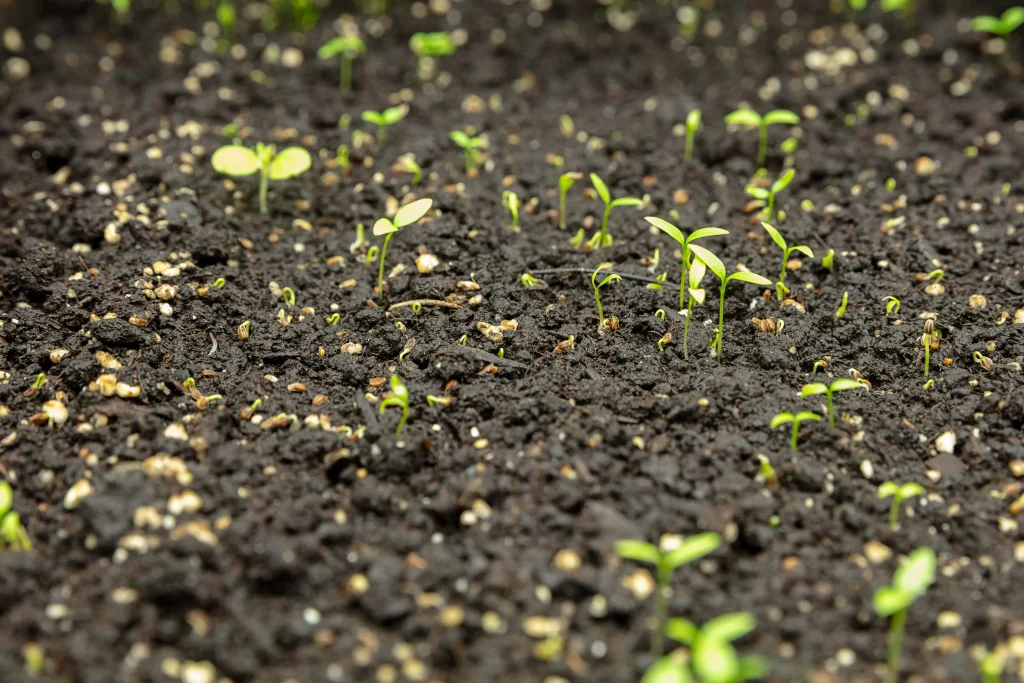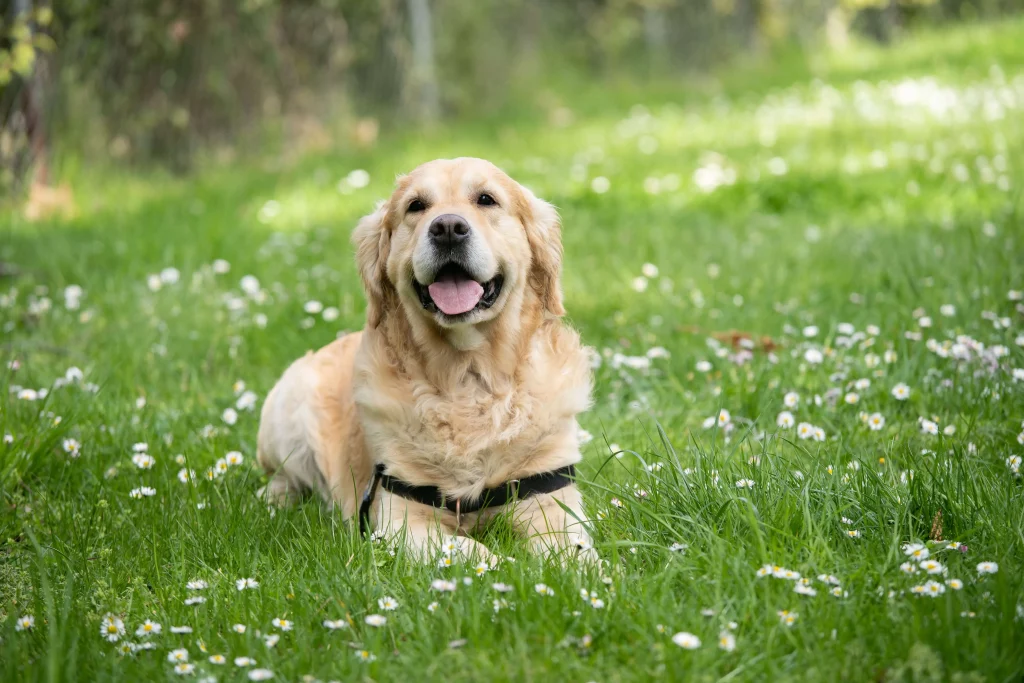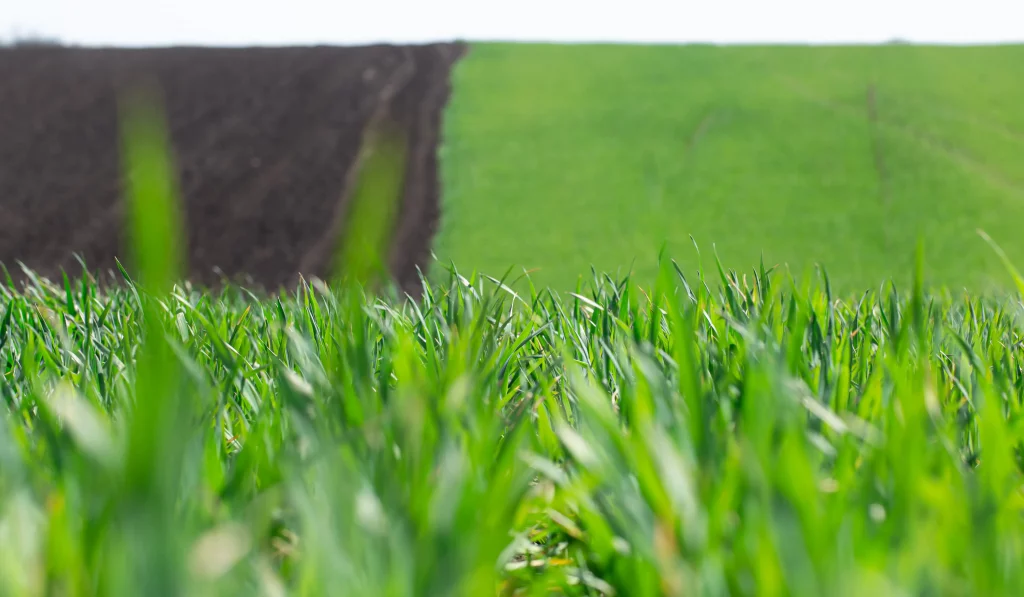Soil and sod in Southeast Michigan – let’s dive in the its diversity. The soil type in Southeast Michigan can vary, but generally, it consists of a mixture of glacial till, sand, and clay. The glacial till was deposited by glaciers during the last ice age, while sand and clay deposits were formed by ancient seas and rivers. As for sod, there are various types of grass that can grow well in Southeast Michigan, including Kentucky Bluegrass, Perennial Ryegrass, and Fine Fescue.
When choosing a sod type, it’s important to consider factors such as climate, soil type, and intended use. It’s also essential to ensure proper soil preparation and maintenance to ensure healthy sod growth.
Sods in Michigan
The best type of sod for Michigan depends on several factors such as climate, soil type, intended use, and personal preference. However, some of the most commonly used sod types in Michigan include Kentucky Bluegrass, Perennial Ryegrass, and Fine Fescue.
| Type | Kentucky Blue-grass | Fine Fescue | Perennial Ryegrass |
| Color | Deep Emerald Blue-green | Medium to dark green | Pale to Medium Green |
| Classification | Cool-Season grass | Cool-Season grass | Cool-Season grass |
| Maintenance | Moderate | low | low |
| Spread by | Rhizomes | Bunch forming | Tillers; vertical shoots |
| Shade Tolerance | Moderate | High | Partial |
| Potential for disease | Less resistant to weeds and disease. | More resistant to weeds and disease. | More resistant to weeds and disease |
| Growth | moderate | Faster than KBG | least |
| watering | Frequently, specifically in hot weather | Less Watering requirement. | 1 inch water once in a week |
| Ideal time to grow | Early Fall | Fall and Spring | Early Fall |
| Sunlight | 8 hours a day approx | 4 hours a day approx | 4-5 hours a day approx. |
Kentucky Bluegrass is a popular choice for homeowners because it is drought-resistant and can withstand heavy foot traffic. It has a fine texture and a dark green color, making it an aesthetically pleasing option for a lawn.
Fine Fescue is a great choice for shady areas because it can tolerate low-light conditions. It has a fine texture and a light green color, making it a popular choice for those who prefer a more natural-looking lawn.
Perennial Ryegrass is another popular choice for Michigan because it establishes quickly and can tolerate cold temperatures. It has a medium texture and a bright green color, making it ideal for a lush-looking lawn.
Ultimately, the best type of sod for Michigan will depend on your individual needs and preferences. It’s important to consult with a local turf expert to determine which sod type will thrive in your specific area and climate.
Sod Installation in South-east Michigan

If you want to install sod in Southeast Michigan, it’s important to prepare your soil properly to ensure successful growth. Here are some steps you can take to fix your soil for sod installation:
1. Test your soil: Before you install sod, it’s important to test your soil to determine its pH level, nutrient content, and texture. You can get a soil test kit from your local garden center or university extension office. Once you know the soil composition, you can make the necessary amendments.
2. Amend the soil: Based on the soil test results, you may need to amend your soil by adding organic matter or nutrients. Adding compost or aged manure can help improve soil structure and fertility. You may also need to add lime to adjust the pH level of your soil.
3. Level the soil: It’s important to ensure that your soil is level before installing sod. Use a rake or roller to smooth out any bumps or depressions in the soil.
4. Prepare the soil: Sod needs good soil contact to establish roots, so it’s important to prepare the soil properly. Use a rototiller to loosen the top 4-6 inches of soil and remove any rocks or debris. Then, use a rake to smooth out the soil and create a level surface.
5. Install the sod: Once your soil is prepared, it’s time to install the sod. Lay the sod in a brick-like pattern, making sure the edges are tightly butted together. Then, use a roller to press the sod firmly into the soil.
6. Water the sod: After installation, it’s important to water the sod thoroughly to ensure that the roots establish. Water the sod deeply and frequently for the first two weeks, then gradually reduce the frequency as the sod becomes established.
By following these steps, you can fix your soil for sod installation and create a healthy, beautiful lawn in Southeast Michigan or you can directly consult with Professional Landscapers in Michigan. Schedule a meeting and get free estimate from Grow Earth.
6 Expert Tips for Landscaping a Shaded Yard
Growing grass in a shaded area can be a bit challenging, but it is still possible to achieve a lush green lawn. Here are some tips for growing grass in a shaded area:
- Choose the right grass seed: Not all grass species thrive in shade. Select grass seed that is specifically designed for shady areas. Fine fescues, creeping red fescues, and turf-type tall fescues are all good options for shady areas.
- Prune trees and shrubs: If your shaded area is due to trees and shrubs, consider pruning them to allow more sunlight to penetrate through to the ground. This will help to promote grass growth.
- Improve soil quality: Grass needs good soil to grow. In shaded areas, the soil may be compacted and lack nutrients. Loosen the soil with a rake or aerator, and add compost or organic matter to improve the soil quality.
- Water properly: Grass in shaded areas needs less water than grass in sunny areas. Water deeply and infrequently, rather than frequently and shallowly.
- Avoid high traffic: Grass in shaded areas is more delicate than grass in sunny areas. Avoid walking or playing on the grass in shaded areas, as this can damage the grass.
- Consider alternative ground covers: If grass doesn’t grow well in your shaded area, consider alternative ground covers such as moss or ground covers that thrive in shade, like hostas or ferns.
Shade Tolerant Grass Seed
If you are looking for shade-tolerant grass seed to grow in areas with limited sunlight, here are some options to consider:
Fine Fescue: Fine fescue is a cool-season grass that grows well in shade and requires less fertilizer and water than other grasses. It’s a good choice for areas with moderate to heavy shade.
Creeping Red Fescue: Creeping red fescue is another cool-season grass that grows well in shade and has a fine texture. It’s often used as a component in shade-tolerant seed mixes.
Turf-type Tall Fescue: Turf-type tall fescue is a hardy grass that grows well in both sun and shade. It’s often used in seed mixes for shady areas and has a deep root system that makes it more drought-tolerant.
Kentucky Bluegrass: Kentucky bluegrass is a popular choice for lawns in cooler climates and can tolerate some shade. It has a fine texture and a deep green color. Moreover, it requires more maintenance and water than some other shade-tolerant grasses.
Zoysia Grass: Zoysia grass is a warm-season grass. It can tolerate some shade and is known for its low maintenance requirements. It has a coarse texture and can take longer to establish than other grasses.
The Effects of Dogs on Your Lawn: Tips for a Healthy Yard

As a dog owner, you may have experienced how your beloved pet can affect the appearance of your lawn. From digging holes to leaving yellow spots, dogs can pose challenges to maintaining a pristine yard. let’s discuss the impact of dogs on your lawn
- Urine: Dog urine contains nitrogen and it can cause the grass to turn yellow or brown in spots where the dog urinates. This is often referred to as “dog spots” or “burn spots.” Female dogs tend to cause more damage than males, as they typically urinate in one spot for a longer period.
- Digging: Dogs have a natural instinct to dig, which can cause damage to grass and create bare spots. Some breeds, such as terriers, are more prone to digging than others.
- Traffic: Dogs running and playing on grass can cause soil compaction which can lead to thinning and bald spots.
- Feces: Dog feces can contain harmful bacteria that can damage grass and pose a health risk to humans and other animals.
On the positive side, dogs can also have some beneficial effects on grass, such as:
- Fertilization: As mentioned earlier, dog urine contains nitrogen, which can fertilize the grass and promote growth in small amounts.
- Aeration: Dogs running and playing on grass can help to aerate the soil and improve drainage.
To minimize the negative effects of dogs on grass, it’s important to train them to poop in a designated area. Keep the grass well-watered and fertilized, and provide plenty of toys and exercise to discourage digging and excessive running. Regularly picking up and disposing of dog feces can also help to prevent the spread of harmful bacteria and keep the grass healthy.
Frequently Asked Questions
Sod refers to grass and soil is pre-grown on a farm that is cut into pieces for installation in a landscaped area.
The optimal time to install sod in Michigan is early fall, so that your sod get enough time to grow its roots efficiently.
Choosing the correct type of sod for your lawn requires a few considerations. The growth of sod depends on soil and weather conditions. In Southeast Michigan, people commonly use Kentucky Bluegrass and fescue due to their tolerance to cool weather.


